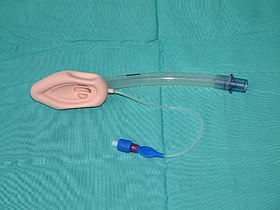This article has multiple issues. Please help improve it or discuss these issues on the talk page. (Learn how and when to remove these messages)
|
| Laryngeal mask airway | |
|---|---|
 A laryngeal mask | |
| Specialty | Anaesthetics |
A laryngeal mask airway (LMA), also known as laryngeal mask, is a medical device that keeps a patient's airway open during anaesthesia or while they are unconscious. It is a type of supraglottic airway device. They are most commonly used by anaesthetists to channel oxygen or inhalational anaesthetic to the lungs during surgery and in the pre-hospital setting (for instance by paramedics and emergency medical technicians) for unconscious patients.[citation needed]
A laryngeal mask is composed of an airway tube that connects to an elliptical mask with a cuff which is inserted through the patient's mouth, down the windpipe, and once deployed forms an airtight seal on top the glottis (unlike tracheal tubes which pass through the glottis) allowing a secure airway to be managed by a health care provider.
The laryngeal mask was invented by British anaesthesiologist Archibald Brain in the early 1980s, and in December 1987 the first commercial laryngeal mask was made available in the United Kingdom. The laryngeal mask is still widely used today worldwide, and a variety of specialised laryngeal masks exist.